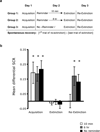Preventing the return of fear in humans using reconsolidation update mechanisms
- PMID: 20010606
- PMCID: PMC3640262
- DOI: 10.1038/nature08637
Preventing the return of fear in humans using reconsolidation update mechanisms
Erratum in
-
Addendum: Preventing the return of fear in humans using reconsolidation update mechanisms.Nature. 2018 Oct;562(7727):E21. doi: 10.1038/s41586-018-0405-7. Nature. 2018. PMID: 30050064 No abstract available.
Abstract
Recent research on changing fears has examined targeting reconsolidation. During reconsolidation, stored information is rendered labile after being retrieved. Pharmacological manipulations at this stage result in an inability to retrieve the memories at later times, suggesting that they are erased or persistently inhibited. Unfortunately, the use of these pharmacological manipulations in humans can be problematic. Here we introduce a non-invasive technique to target the reconsolidation of fear memories in humans. We provide evidence that old fear memories can be updated with non-fearful information provided during the reconsolidation window. As a consequence, fear responses are no longer expressed, an effect that lasted at least a year and was selective only to reactivated memories without affecting others. These findings demonstrate the adaptive role of reconsolidation as a window of opportunity to rewrite emotional memories, and suggest a non-invasive technique that can be used safely in humans to prevent the return of fear.
Figures



Comment in
-
Neuroscience: Editing out fear.Nature. 2010 Jan 7;463(7277):36-7. doi: 10.1038/463036a. Nature. 2010. PMID: 20054384 No abstract available.
Similar articles
-
Neuroscience: Editing out fear.Nature. 2010 Jan 7;463(7277):36-7. doi: 10.1038/463036a. Nature. 2010. PMID: 20054384 No abstract available.
-
Young and old Pavlovian fear memories can be modified with extinction training during reconsolidation in humans.Learn Mem. 2014 Jun 16;21(7):338-41. doi: 10.1101/lm.033589.113. Print 2014 Jul. Learn Mem. 2014. PMID: 24934333 Free PMC article. Clinical Trial.
-
The role of prediction error and memory destabilization in extinction of cued-fear within the reconsolidation window.Neuropsychopharmacology. 2019 Sep;44(10):1762-1768. doi: 10.1038/s41386-018-0299-y. Epub 2018 Dec 20. Neuropsychopharmacology. 2019. PMID: 30659275 Free PMC article.
-
Prediction Error and Memory Reactivation: How Incomplete Reminders Drive Reconsolidation.Trends Neurosci. 2019 Oct;42(10):727-739. doi: 10.1016/j.tins.2019.08.007. Epub 2019 Sep 7. Trends Neurosci. 2019. PMID: 31506189 Review.
-
Erasing fear memories with extinction training.J Neurosci. 2010 Nov 10;30(45):14993-7. doi: 10.1523/JNEUROSCI.4268-10.2010. J Neurosci. 2010. PMID: 21068303 Free PMC article. Review.
Cited by
-
Disrupting reconsolidation of fear memory in humans by a noradrenergic β-blocker.J Vis Exp. 2014 Dec 18;(94):52151. doi: 10.3791/52151. J Vis Exp. 2014. PMID: 25549103 Free PMC article. Clinical Trial.
-
Extinction during memory reconsolidation blocks recovery of fear in adolescents.Sci Rep. 2015 Mar 9;5:8863. doi: 10.1038/srep08863. Sci Rep. 2015. PMID: 25749583 Free PMC article.
-
Fear extinction as a model for translational neuroscience: ten years of progress.Annu Rev Psychol. 2012;63:129-51. doi: 10.1146/annurev.psych.121208.131631. Annu Rev Psychol. 2012. PMID: 22129456 Free PMC article. Review.
-
Sleep and REM sleep disturbance in the pathophysiology of PTSD: the role of extinction memory.Biol Mood Anxiety Disord. 2015 May 29;5:3. doi: 10.1186/s13587-015-0018-9. eCollection 2015. Biol Mood Anxiety Disord. 2015. PMID: 26034578 Free PMC article.
-
Cholinergic blockade frees fear extinction from its contextual dependency.Biol Psychiatry. 2013 Feb 15;73(4):345-52. doi: 10.1016/j.biopsych.2012.08.006. Epub 2012 Sep 12. Biol Psychiatry. 2013. PMID: 22981655 Free PMC article.
References
-
- Miracle AD, Brace MF, Huyck KD, Singler SA, Wellman CL. Chronic stress impairs recall of extinction of conditioned fear. Neurobio. Learn. Mem. 2006;85:213–218. - PubMed
-
- Misanin JR, Miller RR, Lewis DJ. Retrograde amnesia produced by electro-convulsive shock after reactivation of a consolidated memory trace. Science. 1968;160:203–204. - PubMed
-
- Alberini CM. Mechanisms of memory stabilization: are consolidation and reconsolidation similar or distinct processes? Trends Neuro. 2005;28:51–56. - PubMed
-
- Nader K, Schafe GE, LeDoux JE. Fear memories require protein synthesis in the amygdala for reconsolidation after retrieval. Nature. 2000;406:722–726. - PubMed
-
- Dudai Y. Reconsolidation: the advantage of being refocused. Curr. Opin. Neurobiol. 2006;16:174–178. - PubMed
Publication types
MeSH terms
Grants and funding
LinkOut - more resources
Full Text Sources
Other Literature Sources
Medical
Research Materials

